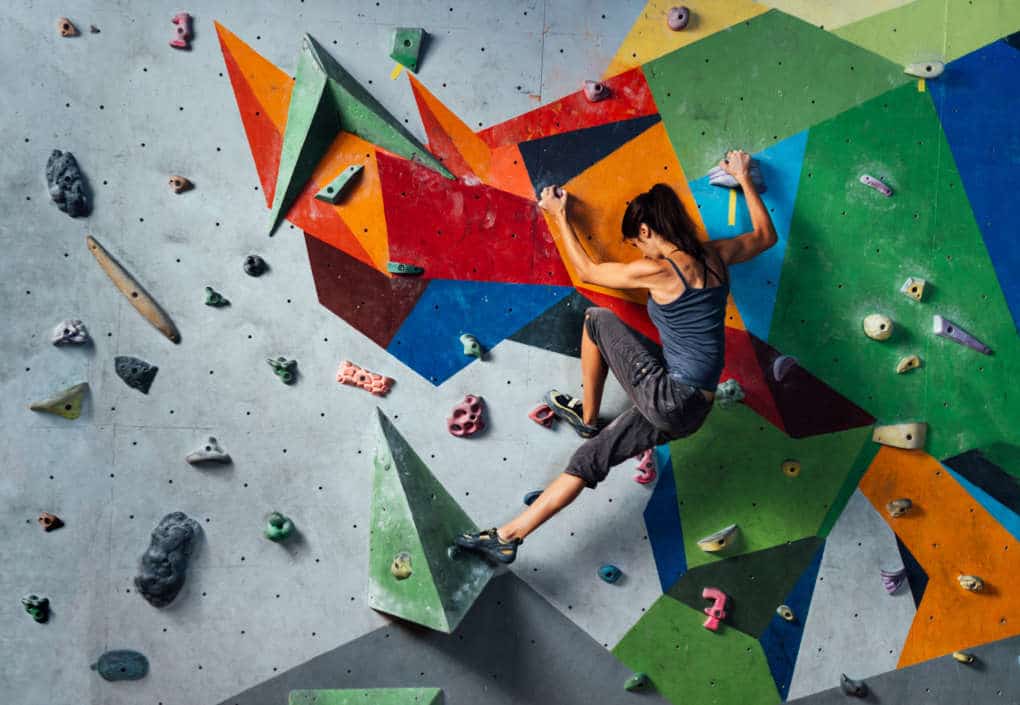Climbing is a diverse sport. It’s one verb for the swinging of ice axes in frosty Ouray Ice Park, CO, and using the warm Mediterranean as your bouldering pad in Majorca, Spain. There is a universal aspect to climbing, whether it’s ice climbing or deep-water soloing, and that’s the value of footwork. Welcome to On Sight, a technique and tip blog run by your very own Tufas Boulder Lounge staff! Every week we focus on how to maximize our climbing potential. This week we’re looking down so we can climb up with Bouldering Basics: Climbing Footwork.
Why It Matters
“Climbing is all about stepping up to holds rather than pulling yourself up the wall,” says Caleb, one of the route setters at Tufas. “Footwork is vital, especially as climbers move through the grades to more demanding boulder problems.”
A well-rounded skill set, Caleb says, builds on a well-practiced foundation.
“It’s hard to overstate the importance of not only practicing the basics but practicing them well.”
Keeping your weight on your feet can also substantially reduce fatigue by taking the strain off your arms.
Walls, Volumes, Holds
The art of setting is ever-evolving, but it’s based on a simple foundation: the wall, the volumes, and the holds. The wall is what volumes and holds are attached to. It can also refer to the angle of the wall, whether it meets another wall and forms a dihedral, or forms a comfortable arete, or end, on one side that can be used as a hold.
Different wall angles require different approaches, for more on this check out our Bouldering Basics: Climbing Slab, and Bouldering Basics: Climbing in the Steep, and Bouldering Basics: Climbing Overhangs On Sight article series.
The volumes are the large, geometric prisms screwed on to the wall. Volumes can have holds attached to them, but don’t have to to be considered as part of a climb. Route setters can use volumes to manipulate the angle of a wall in substantial ways.
Finally, we have holds. They are the monochromatic roadmap of the boulder problem, and your compass is ergonomics. Holds on the wall, and on the volume, are typically broken down into larger and more comfortable handholds, intended to guide the climber’s hands through the sequence, and smaller footholds that serve as the guides for your feet. As climbs get more complicated, the holds become smaller and further apart, with the angle of the wall steepening.
Climbing is often reading the language of the climb, also known as the intended beta, and trying to perform the movements that the route requires.

The Magic Geometry of Bouldering: Three-Point Climbing
Triangles are a notoriously stable shape. In climbing, just as in economics, stability is valuable and something we strive to achieve. In your climbing, try to imitate the strong and stable shape of the triangle by keeping three points of contact on the wall. This can be any combination of hands and feet as long as there are three stable points.
Imagine standing on a ladder without using your hands to balance and reaching behind you for a can on the top shelf: only having two points of contact is substantially less stable. Furthermore, having three points of connection provides a vital redundancy. If your left foot slips, having your right hand as a back-up can help you stay on the wall, or the ladder. Use this math-e-magical thinking to ascend and descend stably.
Basic Footwork for Bouldering
Climbing bouldering problems are often not as straightforward as climbing a ladder. Although climbing with your arms straight, using your legs to propel you upwards, and maintaining three points of contact are universal between the two, bouldering entails diverse foot movement, in contrast to the left-right-left rhythm of climbing a ladder. Setters dream up of ways to have climbers perform these movements, a practice known as “forcing a move.”

The Foot Switch
The Foot Switch is an essential tool invaluable to any climber who unlocks its full potential. To perform a Foot Switch, bring one foot over the other, with one big toe over the other one. Then as you slide out the lower foot, bring the higher foot in its place. This is especially useful if the foothold you are using is too small to accommodate both of your feet (also known as matching feet).
The Step Through
Whether it is as little as crossing your ankles, or as high up as crossing over your knees, the step through is an invaluable technique that is used by beginners and professionals alike. It can save energy while simultaneously providing elegance and stability to your climbing. The movement is pretty straightforward: your left foot goes across your body, past the right foot, onto a foothold, and then your right foot steps from behind your left, unwinding your body as it moves past the left foot and to the next foothold.
The step through is also useful in reverse. Imagine that instead of moving left to right, like in the last example, imagine moving from right to left. Now, instead of bringing your right foot across the front of your body, go behind your left leg, and unwind similarly.
The Back Step
The back step is a powerful and simple tool in your footwork arsenal. Typically, this movement is used to reach diagonally for holds that are just out of reach. For the Back Step, you want to press the hip of the leg you will be stepping with into the wall and step onto the footholds with the outer edge (pinky-toe side) of your foot. Slowly shift your weight onto your leg as your reach for the handhold that is further out while simultaneously unweighing your other foot. To unwind from this position, you can rotate your hips and square them to the wall and shifting the weight from the pinky-toe side to the big toe or use a simple Step Through behind the Back Stepped leg.
The Smear
Sometimes there are no footholds for you to step on. Instead, you might be confronted with blank space on the wall or the textured edge of a large volume. When there appears to be a notable absence of clearly marked footholds, there is room for smearing. The name of the game with smearing is merely using the friction between your climbing shoes and the wall or textured volume as your primary source of foot placement and body propulsion. This technique requires commitment, balance, and trust in your footwear (an ill-fitting shoe will not do!).
Let’s Review!
Climbing is a dance that does not tolerate laziness and rewards precise, efficient movement. Sprinkling a little fancy footwork not only looks good on the wall but also provides a roadmap for efficiency and stability for the rest of your body to follow. Whether it is by extending your reach with a backstep, cutting down on footswitches with a step through, or moving through a remarkably blank crux section with a confident smear, good footwork often makes a notable difference in performance.
Just like how a sharp scalpel is necessary for delicate surgery, a well-fitting and reliable climbing shoe is essential for precise and effective footwork. Climbing shoes come in a diverse variety of materials, closures, shapes, and designs specialized for bouldering, sport, or trad climbing. Although virtually all of them have specialized, sticky climbing rubber on the soles and shape the foot in a way that makes it easier to stand on smaller footholds with your toes, they are not one-size, or -shape fits all. For a closer look at climbing shoes, check out our Bouldering Basics: Climbing Shoes. For an up-to-date list of climbing shoes, we offer at our locations, check out the Tufas Gear Reviews pages!
Z. Kudratov wrote this, among other things. He’s an imported Philadelphian with a soft spot for public transportation, public radio, and the PMA.